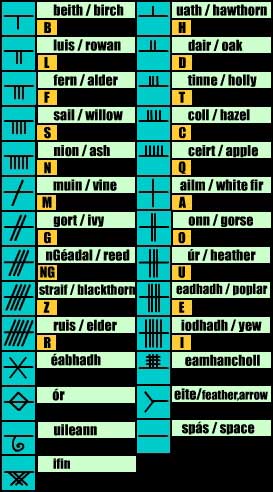Ogham - an Ancient Celtic Alphabet
Created | Updated Jul 9, 2009

Ogham (pronounced 'oh-um') is an ancient alphabet which was used for inscriptions on stones in Ireland, and the United Kingdom, in 4th Century AD. There are only about 375 inscriptions known and 316 of these are from Ireland. Most of them consist of just a person's name. Irish tradition says that the alphabet was once used on wooden posts, but there are no known examples.
The alphabet is designed to be written along an edge of a stone using straight and diagonal strokes which cross the edge or lie on one side or the other of the edge. The edge may be horizontal or vertical. Vertical inscriptions may be written from top to bottom, or bottom to top.
The basic Ogham alphabet consists of 20 letters. Each consists of between one and five parallel strokes. The strokes can be on the left of the edge, on the right, crossing the edge, or crossing it obliquely. The oblique stroke sometimes appears as a dot on the edge.
The sounds associated with each letter are known from ancient Irish writings. As well as a sound, each letter is traditionally associated with a tree name which starts with the same sound. These are given in the following diagram.

The Ogham alphabet also includes seven extra characters which do not look like any of the others. They appear to have been added later and are used for sounds which do not appear in ancient Irish.
Original Idea or Based on the Roman Alphabet?
Was the Ogham alphabet invented by someone who knew nothing of the Roman alphabet, or was it based on the Roman alphabet? Scholars are not able to agree on this one.
In the 'based on Roman' camp, the arguments run as follows:
Although the Romans never invaded Ireland, it is likely that their writing was known to the well educated in Ireland by the 4th Century AD, as they had occupied Great Britain for 400 years at this stage. St Patrick arrived in Ireland about this time and he was well versed in Latin.
The Ogham alphabet contains sounds which do not occur in the Irish language of the time, although they do occur in Latin - 'H' and 'Z'.
The invention of vowels is a much rarer occurrence than the invention of alphabets in general. Many ancient European and middle Eastern alphabets had signs for consonants but none for vowels. The Ogham has five vowels and they are exactly the same ones as the Roman alphabet.
On the other hand, the 'independent invention' arguments are:
The order of the letters in the alphabet is completely different from that of the Roman alphabet.
There is one sign for a sound, NG, which is represented by two letters in the Roman alphabet. The inventors need not have wasted a sign if they knew about using the N sign and the G sign.
The Ogham inscriptions are most common in the parts of Ireland where the Romans were least likely to have influence - in the southwest.
Strange Theories
There are a number of strange theories concerning the Ogham alphabet. One theory is that it was a secret writing, known only to a priest class. While this may have been the original purpose of the alphabet, it was certainly not kept secret. In Wales, most of the inscriptions are accompanied by a translation in the Roman alphabet.
Another is that it originated in Central Europe and was carried west to Ireland with the migration of the Celts. The evidence for this is that some of the traditional tree names for the letters are trees that are not found in Ireland. But Ogham inscriptions are not found anywhere in continental Europe and most inscriptions occur in southern Ireland. It is more likely that the alphabet was devised there.
Accounts of using the Ogham letters for magical purposes or divination seem to be entirely fiction, generated in the 20th Century.

